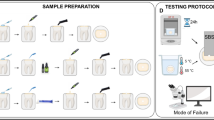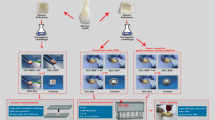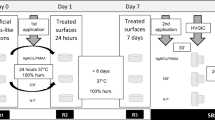Abstract
Objectives
This study investigated the ability of modified phosphoric acids containing chlorhexidine (CHX) or grape seed extract (GSE) for promoting simultaneous biomodification during acid etching on bonding properties in caries-affected dentin (CAD).
Materials and methods
Thirty-two human molars (8 with sound dentin [SD] and 24 naturally CAD) were selected for the study. The SD and CAD were initially exposed, then randomized and etched according to the following groups: (1) SD (SD-CT) and CAD (CAD-CT) both with 37% phosphoric acid, (2) CAD with 2% CHX containing 37% phosphoric acid (CAD-CHX), and (3) CAD with 2% GSE containing 10% phosphoric acid (CAD-GSE). The bonding procedure and composite build-ups were performed after acid etching. Subsequently, they were sectioned in resin-dentin specimens. The specimens were submitted for chemical profiling by micro-Raman, microtensile bond strength (μTBS), failure mode with chemical characterization by FEG/SEM-EDX, and in situ zymography by CLSM. The data from μTBS and CLSM were statistically analyzed (1-way ANOVA and Tukey’s test; α = 0.05).
Results
The highest μTBS results were shown for SD-CT in comparison with all CAD groups (p < 0.001), and the lowest for CAD-CT and CAD-CHX (p < 0.001). The etching with CHX did not increase the μTBS for CAD when compared with CT (p = 0.52). However, the etching with GSE improved significantly the μTBS for CAD when compared with CT and CHX (p < 0.001). The chemical profile detected chemical and structural changes in collagen peaks for CAD-CT, which were not detected when the CAD was etched by modified acids. Also, the poorest hybridization ability was detected in CAD for CT, which was significantly improved with modified acids, especially the GSE, as evaluated by chemical profile and failure mode. A significant reduction of MMP activity on CAD was promoted by modified acids in comparison with CT (both p < 0.001).
Conclusions
The GSE-containing acid was able to promote biomodification during the acid etching, increasing the bonding properties and reducing the activity of the MMPs within the hybrid layer.
Clinical relevance
The use of GSE-containing phosphoric acid can be a promising alternative to improve the bonding performance on caries-affected dentin, since it is capable of biomodifying the dentin during the acid etching, without adding any extra step in bonding procedures.




Similar content being viewed by others
References
Bjorndal L (2002) Buonocore Memorial Lecture. Dentin caries: progression and clinical management. Oper Dent 27(3):211–217
Wang Y, Spencer P, Walker MP (2007) Chemical profile of adhesive/caries-affected dentin interfaces using Raman microspectroscopy. J Biomed Mater Res A 81(2):279–286
Franzon R, Guimarães LF, Magalhães CE, Haas AN, Araujo FB (2014) Outcomes of one-step incomplete and complete excavation in primary teeth: a 24-month randomized controlled trial. Caries Res 48(5):376–383
Maltz M et al (2002) A clinical, microbiologic, and radiographic study of deep caries lesions after incomplete caries removal. Quintessence Int 33(2):151–159
Hass V, Cardenas AFM, Siqueira FSF, Pacheco RR, Zago PMW, Silva DO, Bandeca MC, Loguercio AD (2019) Bonding performance of universal adhesive systems applied in etch-and-rinse and self-etch strategies on natural dentin caries. Oper Dent 44(5):510–520
Yoshiyama M, Tay FR, Doi J, Nishitani Y, Yamada T, Itou K, Carvalho RM, Nakajima M, Pashley DH (2002) Bonding of self-etch and total-etch adhesives to carious dentin. J Dent Res 81(8):556–560
Goldberg M, Kulkarni AB, Young M, Boskey A (2011) Dentin: structure, composition and mineralization. Front Biosci (Elite Ed) 3:711–735
Bedran-Russo AK et al (2011) Characterization of biomodified dentin matrices for potential preventive and reparative therapies. Acta Biomater 7(4):1735–1741
Beniash E, Traub W, Veis A, Weiner S (2000) A transmission electron microscope study using vitrified ice sections of predentin: structural changes in the dentin collagenous matrix prior to mineralization. J Struct Biol 132(3):212–225
Marshall GW Jr et al (1997) The dentin substrate: structure and properties related to bonding. J Dent 25(6):441–458
Mazzoni A, Tjäderhane L, Checchi V, di Lenarda R, Salo T, Tay FR, Pashley DH, Breschi L (2015) Role of dentin MMPs in caries progression and bond stability. J Dent Res 94(2):241–251
Nascimento FD, Minciotti CL, Geraldeli S, Carrilho MR, Pashley DH, Tay FR, Nader HB, Salo T, Tjäderhane L, Tersariol ILS (2011) Cysteine cathepsins in human carious dentin. J Dent Res 90(4):506–511
Tjaderhane L et al (1998) The activation and function of host matrix metalloproteinases in dentin matrix breakdown in caries lesions. J Dent Res 77(8):1622–1629
Carrilho MR et al (2007) Chlorhexidine preserves dentin bond in vitro. J Dent Res 86(1):90–94
Hebling J, Pashley DH, Tjäderhane L, Tay FR (2005) Chlorhexidine arrests subclinical degradation of dentin hybrid layers in vivo. J Dent Res 84(8):741–746
Stanislawczuk R, Reis A, Loguercio AD (2011) A 2-year in vitro evaluation of a chlorhexidine-containing acid on the durability of resin-dentin interfaces. J Dent 39(1):40–47
Bedran-Russo AK et al (2007) Application of crosslinkers to dentin collagen enhances the ultimate tensile strength. J Biomed Mater Res B Appl Biomater 80(1):268–272
Cova A, Breschi L, Nato F, Ruggeri A Jr, Carrilho M, Tjäderhane L, Prati C, di Lenarda R, Tay FR, Pashley DH, Mazzoni A (2011) Effect of UVA-activated riboflavin on dentin bonding. J Dent Res 90(12):1439–1445
Hass V, de Paula AM, Parreiras S, Gutiérrez MF, Luque-Martinez I, de Paris Matos T, Bandeca MC, Loguercio AD, Yao X, Wang Y, Reis A (2016) Degradation of dentin-bonded interfaces treated with collagen cross-linking agents in a cariogenic oral environment: an in situ study. J Dent 49:60–67
Sabatini C, Pashley DH (2014) Mechanisms regulating the degradation of dentin matrices by endogenous dentin proteases and their role in dental adhesion. A review. Am J Dent 27(4):203–214
Pashley DH, Tay FR, Breschi L, Tjäderhane L, Carvalho RM, Carrilho M, Tezvergil-Mutluay A (2011) State of the art etch-and-rinse adhesives. Dent Mater 27(1):1–16
Loguercio AD, Malaquias P, Dos Santos FP, Hass V, Stanislawczuk R, Lima SNL, Bandeca MC, Reis A (2017) Acid etching with modified phosphoric acid to increase the longevity of the bonded interface. J Adhes Dent:195–201
Hass V, Luque-Martinez I, Muñoz MA, Reyes MFG, Abuna G, Sinhoreti MAC, Liu AY, Loguercio AD, Wang Y, Reis A (2016) The effect of proanthocyanidin-containing 10% phosphoric acid on bonding properties and MMP inhibition. Dent Mater 32(3):468–475
Liu Y, Dusevich V, Wang Y (2014) Addition of grape seed extract renders phosphoric acid a collagen-stabilizing etchant. J Dent Res 93(8):821–827
Gugnani N et al (2011) International Caries Detection and Assessment System (ICDAS): a new concept. Int J Clin Pediatr Dent 4(2):93–100
Ismail AI, Sohn W, Tellez M, Amaya A, Sen A, Hasson H, Pitts NB (2007) The International Caries Detection and Assessment System (ICDAS): an integrated system for measuring dental caries. Community Dent Oral Epidemiol 35(3):170–178
Suyama Y, Lührs AK, de Munck J, Mine A, Poitevin A, Yamada T, van Meerbeek B, Cardoso MV (2013) Potential smear layer interference with bonding of self-etching adhesives to dentin. J Adhes Dent 15(4):317–324
Mazzoni A, Nascimento FD, Carrilho M, Tersariol I, Papa V, Tjäderhane L, di Lenarda R, Tay FR, Pashley DH, Breschi L (2012) MMP activity in the hybrid layer detected with in situ zymography. J Dent Res 91(5):467–472
Mine A, de Munck J, Cardoso MV, van Landuyt KL, Poitevin A, Kuboki T, Yoshida Y, Suzuki K, Lambrechts P, van Meerbeek B (2009) Bonding effectiveness of two contemporary self-etch adhesives to enamel and dentin. J Dent 37(11):872–883
Reis A, Loguercio AD, Azevedo CL, de Carvalho RM, da Julio Singer M, Grande RH (2003) Moisture spectrum of demineralized dentin for adhesive systems with different solvent bases. J Adhes Dent 5(3):183–192
Bedran-Russo AK, Pauli GF, Chen SN, McAlpine J, Castellan CS, Phansalkar RS, Aguiar TR, Vidal CMP, Napotilano JG, Nam JW, Leme AA (2014) Dentin biomodification: strategies, renewable resources and clinical applications. Dent Mater 30(1):62–76
Hass V, Luque-Martinez IV, Gutierrez MF, Moreira CG, Gotti VB, Feitosa VP, Koller G, Otuki MF, Loguercio AD, Reis A (2016) Collagen cross-linkers on dentin bonding: stability of the adhesive interfaces, degree of conversion of the adhesive, cytotoxicity and in situ MMP inhibition. Dent Mater 32(6):732–741
Wang Y, Spencer P (2002) Quantifying adhesive penetration in adhesive/dentin interface using confocal Raman microspectroscopy. J Biomed Mater Res 59(1):46–55
Marshall GW, Habelitz S, Gallagher R, Balooch M, Balooch G, Marshall SJ (2001) Nanomechanical properties of hydrated carious human dentin. J Dent Res 80(8):1768–1771
Daculsi G, LeGeros RZ, Jean A, Kerebel B (1987) Possible physico-chemical processes in human dentin caries. J Dent Res 66(8):1356–1359
LeGeros RZ (1990) Chemical and crystallographic events in the caries process. J Dent Res 69 Spec No:567–574 discussion 634-6
van Strijp AJ et al (2003) Host-derived proteinases and degradation of dentine collagen in situ. Caries Res 37(1):58–65
Bedran-Russo AK, Karol S, Pashley DH, Viana G (2013) Site specific properties of carious dentin matrices biomodified with collagen cross-linkers. Am J Dent 26(5):244–248
Kuboki Y, Ohgushi K, Fusayama T (1977) Collagen biochemistry of the two layers of carious dentin. J Dent Res 56(10):1233–1237
Macedo GV, Yamauchi M, Bedran-Russo AK (2009) Effects of chemical cross-linkers on caries-affected dentin bonding. J Dent Res 88(12):1096–1100
He L, Mu C, Shi J, Zhang Q, Shi B, Lin W (2011) Modification of collagen with a natural cross-linker, procyanidin. Int J Biol Macromol 48(2):354–359
Liu Y, Wang Y (2013) Proanthocyanidins’ efficacy in stabilizing dentin collagen against enzymatic degradation: MALDI-TOF and FTIR analyses. J Dent 41(6):535–542
Vidal CM et al (2016) Collagen-collagen interactions mediated by plant-derived proanthocyanidins: a spectroscopic and atomic force microscopy study. Acta Biomater 41:110–118
Hagerman AE, Butler LG (1981) The specificity of proanthocyanidin-protein interactions. J Biol Chem 256(9):4494–4497
Blackburn RS, Harvey A, Kettle LL, Manian AP, Payne JD, Russell SJ (2007) Sorption of chlorhexidine on cellulose: mechanism of binding and molecular recognition. J Phys Chem B 111(30):8775–8784
Misra DN (1994) Interaction of chlorhexidine digluconate with and adsorption of chlorhexidine on hydroxyapatite. J Biomed Mater Res 28(11):1375–1381
Jones DS, Brown AF, Woolfson AD, Dennis AC, Matchett LJ, Bell SEJ (2000) Examination of the physical state of chlorhexidine within viscoelastic, bioadhesive semisolids using Raman spectroscopy. J Pharm Sci 89(5):563–571
Kim J, Uchiyama T, Carrilho M, Agee KA, Mazzoni A, Breschi L, Carvalho RM, Tjäderhane L, Looney S, Wimmer C, Tezvergil-Mutluay A, Tay FR, Pashley DH (2010) Chlorhexidine binding to mineralized versus demineralized dentin powder. Dent Mater 26(8):771–778
Perdigao J, Denehy GE, Swift EJ Jr (1994) Effects of chlorhexidine on dentin surfaces and shear bond strengths. Am J Dent 7(2):81–84
Uitto VJ, Turto H, Huttunen A, Lindy S, Uitto J (1980) Activation of human leukocyte collagenase by compounds reacting with sulfhydryl groups. Biochim Biophys Acta 613(1):168–177
Gendron R et al (1999) Inhibition of the activities of matrix metalloproteinases 2, 8, and 9 by chlorhexidine. Clin Diagn Lab Immunol 6(3):437–439
Breschi L, Mazzoni A, Nato F, Carrilho M, Visintini E, Tjäderhane L, Ruggeri A Jr, Tay FR, Dorigo EDS, Pashley DH (2010) Chlorhexidine stabilizes the adhesive interface: a 2-year in vitro study. Dent Mater 26(4):320–325
Loguercio AD, Hass V, Gutierrez MF, Luque-Martinez IV, Szezs A, Stanislawczuk R, Bandeca MC, Reis A (2016) Five-year effects of chlorhexidine on the in vitro durability of resin/dentin interfaces. J Adhes Dent 18(1):35–42
Malaquias P, Gutierrez MF, Hass V, Stanislawczuk R, Bandeca MC, Arrais CAG, Farago PV, Reis A, Loguercio AD (2018) Two-year effects of chlorhexidine-containing adhesives on the in vitro durability of resin-dentin interfaces and modeling of drug release. Oper Dent 43(2):201–212
Carrilho MR et al (2007) In vivo preservation of the hybrid layer by chlorhexidine. J Dent Res 86(6):529–533
Liu R, Fang M, Xiao Y, Li F, Yu L, Zhao S, Shen L, Chen J (2011) The effect of transient proanthocyanidins preconditioning on the cross-linking and mechanical properties of demineralized dentin. J Mater Sci Mater Med 22(11):2403–2411
Funding
This study was partially supported by the State Foundation of Support to Research, Scientific and Technological Development of Maranhão (FAPEMA) from the State Government of Maranhão Brazil under grant number 01641/ 16 and by the National Council for Scientific and Technological Development (CNPq) under grant 308286/2019-7.
Author information
Authors and Affiliations
Corresponding author
Ethics declarations
Conflict of interest
The authors declare that they have no conflict of interest.
Ethical approval
This study was approved by the State University of Ponta Grossa ethics committee.
Informed consent
Informed consent was not obtained because there were no human participants included in the study.
Additional information
Publisher’s note
Springer Nature remains neutral with regard to jurisdictional claims in published maps and institutional affiliations.
Rights and permissions
About this article
Cite this article
Hass, V., da Maceno Oliveira, T.B., Cardenas, A.F.M. et al. Is it possible for a simultaneous biomodification during acid etching on naturally caries-affected dentin bonding?. Clin Oral Invest 25, 3543–3553 (2021). https://doi.org/10.1007/s00784-020-03677-8
Received:
Accepted:
Published:
Issue Date:
DOI: https://doi.org/10.1007/s00784-020-03677-8




